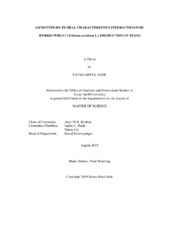| dc.description.abstract | The demand for agricultural and natural recourses is rising due to population growth. Hybrid technology is an effective way to increase yield potential and production of wheat (Triticum aestivum L.) to meet the demand of 9.7 billion people in 2050. Self-pollinated crops are challenging due to high seed production cost and the need to force them to behave as a cross-pollinated crop. Therefore, a compromise between heterosis and floral suitability often needs to be reached in hybrid wheat production. Recently, the interest in hybrid wheat has been renewed because of higher wheat prices, climate change, new technological developments in next-generation sequencing, and capability of predicting heterosis at the molecular level. In addition, the performance potential of hybrids increased due to more focused studies on wheat flower biology.
It is apparent that the redesign of floral characteristics is a prerequisite for hybrid wheat breeding to achieve high outcrossing ability. Therefore, the purpose of this research was to 1) screen the Uniform Variety Trial (UVT) and Texas Elite (TXE) lines for desirable floral characteristics, and 2) characterize the best male and female candidates for inclusion in the Texas A&M AgriLife hybrid wheat crossing blocks.
The lines were screened for floral characteristics such as days to heading, days to anthesis, anther extrusion, anther score, stigma exsertion, gape, and plant height in College Station and McGregor, TX for two years.
The results of combined environment analyses indicated that genotypic variances were significantly different for all floral characteristics. Non-gender and male traits had high heritability estimates. The heritability of anther extrusion ranged from 0.82 to 0.87. The non-gender and male traits exhibited highly reliable genotypic coefficient of variance (GCV), while female traits had low GCV levels. The correlation between days to heading and anthesis; anther score and anther extrusion; as well as stigma exsertion and gape were positive and significant.
The lines were screened for Rht-B1 and Rht-D1 height reduction genes. Five of the UVT lines had Rht-B1a/ Rht-D1b and only one of the TXE lines had it. The rest of the lines had Rht-B1b/ Rht-D1a genes. | en |


